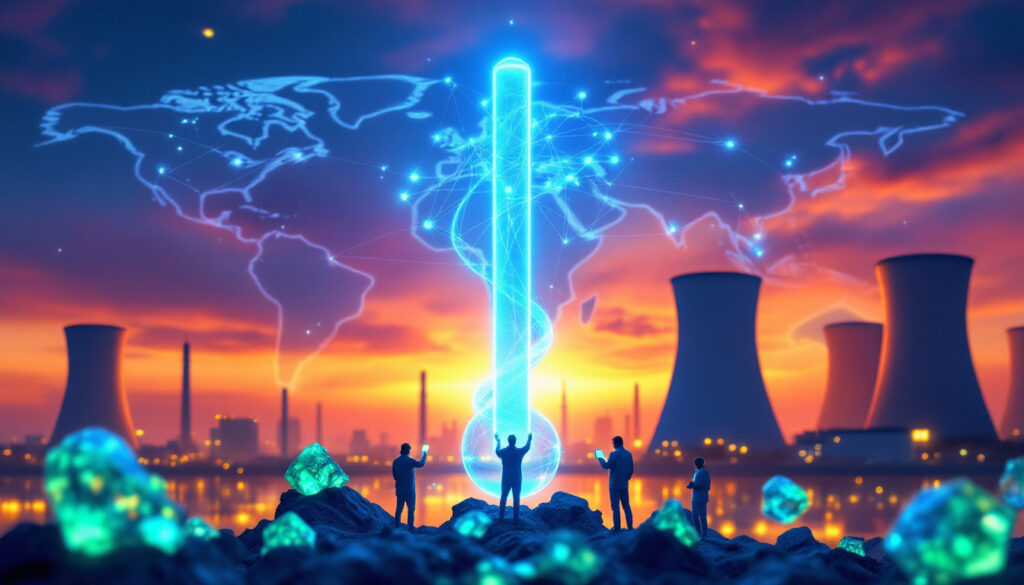Nuclear Energy's Strategic Future: Navigating Global Trade Challenges
The global nuclear energy sector stands at a critical juncture, balancing rising demand for low-carbon power with complex geopolitical and supply chain challenges. Cameco, a leading uranium producer, has emphasized long-term strategic planning to address trade uncertainties, supply chain vulnerabilities, and the need for institutional collaboration. This report analyzes key drivers shaping the industry, including China's reactor expansion, evolving trade policies that are reshaping global trade, and the structural importance of long-term contracts.
What Is Cameco's Long-Term Strategy for Nuclear Energy?
The Growing Importance of Nuclear Fuel Security
Cameco CEO Tim Gitzel has underscored uranium supply security as a cornerstone of global energy stability, particularly amid market volatility driven by geopolitical tensions and shifting trade policies. The company's focus on upstream activities—such as exploration and sustainable mining—aims to mitigate risks associated with overreliance on transient market dynamics insights. For instance, Cameco reported a 12% year-over-year increase in uranium production in its Q1 2025 results, prioritizing output from high-grade deposits in Saskatchewan's Athabasca Basin.
This region accounts for approximately 15% of global uranium supply, with ore grades averaging 10–20 times higher than global averages, reducing both extraction costs and environmental impact.
Gitzel's emphasis on "inevitable and unavoidable" shifts toward supply chain resilience reflects broader industry trends. The World Nuclear Association estimates that primary uranium production must double by 2040 to meet net-zero targets, requiring $50 billion in new investments. However, only 74% of current demand is covered by existing mines, creating a deficit that long-term contracts aim to address.
Adapting to Global Trade Uncertainties
Trade policy disruptions have compelled nuclear fuel buyers to overhaul procurement strategies. In 2024, proposed U.S. tariffs on Russian-enriched uranium prompted utilities to secure conversion and enrichment services before purchasing raw uranium—a reversal of traditional processes. Cameco's response includes diversifying its customer base, with 2025 contracts showing a 30% increase in Asian clients compared to 2023.
This pivot aligns with Gitzel's assertion that "downstream services now dictate upstream decisions," as enrichment bottlenecks could delay reactor fuel assemblies by 18–24 months.
The company's quarterly reports highlight sulphuric acid shortages as a critical vulnerability, with prices surging 40% in 2024 due to reduced fertilizer sector output. As 65% of uranium extraction relies on acid leaching, Cameco has secured multi-year supply agreements with chemical producers, ensuring access to 85% of its required inputs through 2030.
How Are Global Trade Policies Affecting the Nuclear Industry?
Market Access Challenges
The U.S. Department of Energy's 2024 ban on Russian uranium imports above 5% concentration has reshaped global trade flows, with utilities scrambling to replace 24 million pounds annually—20% of U.S. demand. Consequently, Kazakhstan's Kazatomprom has redirected 15% of its exports to Europe, while Cameco's U.S. shipments increased by 22% year-over-year.
However, jurisdictional conflicts persist; Canada's 2025 Critical Minerals Strategy imposes export controls on uranium concentrates, complicating transboundary shipments.
Supply Chain Vulnerabilities
Beyond sulphuric acid, the industry faces logistical hurdles. The 2023 Suez Canal disruptions increased shipping costs for Australian uranium to Europe by 35%, prompting Cameco to stockpile 18 months' worth of inventory at Belgian and U.S. hubs. Additionally, workforce shortages in Canada's mining sector have delayed the Cigar Lake expansion by six months, curtailing planned 2025 output by 1.2 million pounds.
Why Are Long-Term Uranium Contracts Essential?
Supporting Mining Economics
Long-term contracts (10–15 years) provide the revenue certainty needed to finance capital-intensive projects. The McArthur River mine restart, costing $450 million, was contingent on securing 60 million pounds in forward contracts. Such agreements typically include price escalators tied to inflation indices, ensuring real-term returns for miners.
Ensuring Future Supply Stability
With new mine development requiring 10–15 years, utilities are signing offtake deals decades in advance. France's EDF recently inked a 20-year pact with Cameco for 50 million pounds, covering 40% of its projected needs through 2045. These contracts often include flexible delivery clauses, allowing buyers to adjust volumes ±15% annually based on reactor demand.
What Positive Developments Are Driving Nuclear Growth?
Institutional Support and Policy Changes
The World Bank's 2024 decision to fund nuclear projects—ending a 30-year hiatus—unlocks $5 billion annually for emerging economies. Concurrently, the U.S. Nuclear Regulatory Commission has extended operating licenses for 24 reactors to 80 years, preserving 18 GW of capacity through 2060.
China's Expanding Nuclear Program
China's announcement of 10 new reactors annually since 2022 positions it to surpass the U.S. as the largest nuclear operator by 2035. With 27 reactors under construction and 53 planned, the country will require 25 million pounds of uranium yearly by 2030—triple 2023 levels.
This demand has spurred joint ventures; Cameco's partnership with CNNC guarantees 10 million pounds annually for the Hualong One reactor fleet.
How Is Cameco Positioning for Future Growth?
Strategic Exploration Initiatives
Cameco's 2025 exploration budget of $75 million targets the Athabasca Basin's eastern corridor, where geophysical surveys have identified 12 high-priority drill targets. Advanced in-situ recovery (ISR) techniques could reduce water usage by 70% compared to conventional mining, aligning with ESG benchmarks.
Balancing Short-Term Challenges with Long-Term Vision
Despite near-term price volatility, the company maintains a 20-year portfolio of 550 million pounds under contract, ensuring 85% utilization of its 53 million-pound annual capacity. Its $2 billion cash reserve provides flexibility to acquire distressed assets, as seen in the 2024 purchase of Rio Tinto's Roughrider deposits.
What Does the Future Hold for Nuclear Energy Markets?
Emerging Market Trends
The International Energy Agency projects nuclear generation to grow 75% by 2050, necessitating 800 million pounds of annual uranium production. Small modular reactors (SMRs), expected to contribute 10 GW by 2035, will drive demand for LEU+ (19.75% U-235) fuel, currently produced only by Cameco and Orano.
Investment Implications
Uranium equities have outperformed broad commodities since 2020, with the North Shore Global Uranium Mining Index returning 22% CAGR. However, sector concentration risks persist: the top five producers control 58% of supply, necessitating diversified uranium investment opportunities in juniors like NexGen Energy and Denison Mines. Furthermore, thorough uranium market analysis is essential for investors seeking to capitalize on industry growth.
FAQ: Nuclear Energy and Uranium Market
How Are Trade Policies Specifically Impacting Uranium Procurement?
Tariff threats have inverted procurement timelines, with buyers prioritizing enrichment slots over uranium purchases. This shift has increased conversion service premiums by 300% since 2023.
What Role Does China Play in the Global Nuclear Market?
China's 54 operational reactors consume 22 million pounds annually, projected to reach 80 million pounds by 2040. Its state-owned CNNC has optioned 15% of Kazakhstan's 2025 output, tightening Western supply.
Why Is Sulphuric Acid Availability a Concern for Uranium Production?
Sulphuric acid constitutes 30% of in-situ leach mining costs. Planned smelter closures in Chile and Zambia will reduce global output by 12 million tons in 2025, exacerbating shortages.
How Long Can Nuclear Reactors Operate with License Extensions?
U.S. license extensions to 80 years validate advanced materials testing, with reactor vessels showing negligible embrittlement after 60 years. This extends asset lifecycles beyond original 40-year design limits. Unlocking nuclear potential through these extensions represents a significant opportunity for long-term supply-demand balance in the uranium sector.
Further Exploration:
For deeper insights into uranium market dynamics, consult the World Nuclear Association's 2024 Fuel Report and the IAEA's Country Nuclear Power Profiles.
Want to Discover the Next Major Mining Opportunity?
Stay ahead of the ASX market with Discovery Alert's proprietary Discovery IQ model, which provides instant notifications on significant mineral discoveries across all commodities, including uranium. Explore historic returns of major discoveries and start your 30-day free trial at Discovery Alert's discoveries page.




